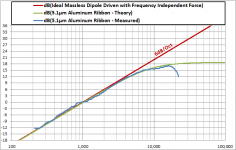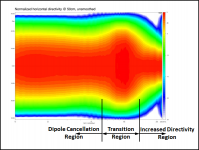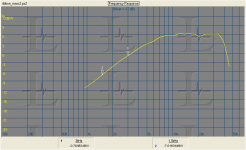I agree with Few, very fine work and very useful measurements. 
This would help define the sensitivity of the ribbon.
I know there will be a trade off in flux density .vs. ribbon area as the width of the ribbon is varied which would affect overall SPL level. But it seemed your comment was directed to the drop-off in HF response on-axis which the ribbon width shouldn’t affect.

Do you know what output level (Vrms or Irms) of the NCore Amplifier was for blue line showing unfiltered ribbon SPL response?All measurements were performed using a Clio FW system and an MBNM 550 EL microphone. The level was calibrated with an ISO-Tech SLC 1356 sound level calibrator so the dBSPL numbers actually mean something
This would help define the sensitivity of the ribbon.
Can you explain what you meant by the “price to pay” comment?…There is a slight drop-off above 16kHz but -2dB at 20kHz is good enough for me, that’s the price one has to pay when using a ribbon that is 19mm wide
I know there will be a trade off in flux density .vs. ribbon area as the width of the ribbon is varied which would affect overall SPL level. But it seemed your comment was directed to the drop-off in HF response on-axis which the ribbon width shouldn’t affect.
I agree with Few, very fine work and very useful measurements.
Do you know what output level (Vrms or Irms) of the NCore Amplifier was for blue line showing unfiltered ribbon SPL response?
This would help define the sensitivity of the ribbon.
Can you explain what you meant by the “price to pay” comment?
I know there will be a trade off in flux density .vs. ribbon area as the width of the ribbon is varied which would affect overall SPL level. But it seemed your comment was directed to the drop-off in HF response on-axis which the ribbon width shouldn’t affect.
Thank you
I didn't record the output level but in a separate measurement I determined the efficiency to be 75dBSPL with 1 Ampère at 2kHz and 50cm distance (there's significant dipole loss at 2kHz).
Yes, I think that the drop-off above 16kHz is due to the ribbon width. Is this not the case? If not, what could be the cause?
Maybe I should perform some measurements at higher sampling rate to see what happens above 20kHz.
regards,
Gerrit
Thanks! That is actually pretty impressive considering you don’t have a magnetic return path.… 75dBSPL with 1 Ampère at 2kHz and 50cm distance…
If it isn’t due to acoustic reasons, and I don’t think it is, it must be from electrical response of the amplifier or microphone/preamp. The amplifier would be easy to check by measuring the voltage drop across your 2 ohm series resistance which would be proportional to current thru the ribbon. My guess is that it is probably the microphone. I have used several condenser mics with response that fell sharply around 20kHz that was not properly compensated in the calibration data. Unfortunately, testing the microphone would require another microphone of known frequency response or a transducer known to have flat response above 20Hz.Yes, I think that the drop-off above 16kHz is due to the ribbon width. Is this not the case? If not, what could be the cause?
I took measurements of a similarly sized dipole ribbon I threw together a few year ago with 11µm aluminum foil and response was flat out to 40kHz, the limit of the B&K 4133 measurement microphone I was using. I’ll see if I can dig up the measurement if you are interested.
Concerning dipole ribbon response:
An ideal weightless ribbon, with minimal baffle frame, and driven with constant current .vs. frequency will have an on-axis, far-field response that increases 6db/octave. This on-axis response trend will be the same no matter what the size or shape of the ribbon is, as long as you are in the far-field. Taking into account the mass of the ribbon, the response will flatten out at higher frequencies when the reactance of the ribbon mass per unit area becomes greater than the radiation resistance(ie acoustic load) the ribbon is pushing against.
Attachment #1 illustrates this principle, compared to your measured response from post #2
Although the on-axis response trend is the same, the polar response will change with different ribbon size/shapes. This is because when the wavelength is larger than the ribbon width, the 6db/octave slope is due to “dipole cancellation” where the acoustic radiation from the rear side of the ribbon diffracts around the frame partially cancelling the acoustic output from the front side. In this frequency range, the polar response will be nearly constant = cos(angle). When the wavelength gets smaller than the ribbon width, the 6dB/octave slope is due to “beaming” or directivity increase. Because of this directivity very little acoustic output reaches the edge of the frame to be diffracted around to the other side. There is a transition region between the two with a bloom in the off-axis response, but the net result is a smooth 6dB/octave slope on-axis with no indication where the transition region is for different size/shape ribbons.
Attachment #2 illustrates this principle, compared to your measured response from post #3
BTW this same +6dB/octave response behavior is also true for ESLs driven with constant voltage, although the transition region is usually at lower frequencies(1kHz - 2kHz) because of the larger widths involved.
http://www.diyaudio.com/forums/plan...se-cancellation-esl-speakers.html#post2856955
Attachments
Thank you very much for providing some theoretical background. If it's not too much work to dig them up I would very much like to see your measurement results.
I definitely have to rebuild my test amplifier and do some more measurements to see if the exact cause of the drop can be determined.
Another kind of measurement:
Although the levels are not the same (the average level for the Seas millennium dome is 85dBSPL) this multi tone comparison clearly shows that the ribbon has much less distortion.
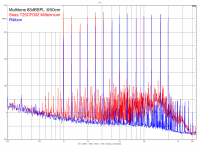
The difference in harmonic levels is too large to be caused by the difference in overall SPL. This to show that the 'sparkle' and 'air' of the ribbon is not due to higher harmonics or intermodulation products. When I have the time I will repeat this comparison with matched levels.
I think that a multi tone spectrum is very useful because it clearly shows any intermodulation products and although it is a steady state signal it is more representative of a musical signal than a stepped sine sweep using a single tone.
regards,
Gerrit
I definitely have to rebuild my test amplifier and do some more measurements to see if the exact cause of the drop can be determined.
Another kind of measurement:
Although the levels are not the same (the average level for the Seas millennium dome is 85dBSPL) this multi tone comparison clearly shows that the ribbon has much less distortion.

The difference in harmonic levels is too large to be caused by the difference in overall SPL. This to show that the 'sparkle' and 'air' of the ribbon is not due to higher harmonics or intermodulation products. When I have the time I will repeat this comparison with matched levels.
I think that a multi tone spectrum is very useful because it clearly shows any intermodulation products and although it is a steady state signal it is more representative of a musical signal than a stepped sine sweep using a single tone.
regards,
Gerrit
Excellent thread!
I really enjoyed reading all the details, after long time this is great new thread about ribbons.
I especially like the way you made aluminum foil thinner, something i never thought about.
After making long 1m quasi ribbons long time ago, I recently had been toying around this type of true ribbons for use as a tweeter in pc speakers. I have made several prototypes, but they all share same kitchen foil as a membrane, which is too thick for good sensitivity. I settled for much narrower 5mm membrane, 110mm long. It makes excellent transient response, and sounds pretty good playing from 5kHz. Wider and longer ribbons went much deeper but sounded duller and slower. I also made embossed instead of corrugated foil, but found no difference in listening or measuring, compared to straight foil.
Only thing left now is to buy thinner foil or to make one myself, using your recipe.
Thanks for great writing and posting results!
I really enjoyed reading all the details, after long time this is great new thread about ribbons.
I especially like the way you made aluminum foil thinner, something i never thought about.
After making long 1m quasi ribbons long time ago, I recently had been toying around this type of true ribbons for use as a tweeter in pc speakers. I have made several prototypes, but they all share same kitchen foil as a membrane, which is too thick for good sensitivity. I settled for much narrower 5mm membrane, 110mm long. It makes excellent transient response, and sounds pretty good playing from 5kHz. Wider and longer ribbons went much deeper but sounded duller and slower. I also made embossed instead of corrugated foil, but found no difference in listening or measuring, compared to straight foil.
Only thing left now is to buy thinner foil or to make one myself, using your recipe.
Thanks for great writing and posting results!
Thank you very much for providing some theoretical background. If it's not too much work to dig them up I would very much like to see your measurement results.
Ok. I'll see if I can locate screen shots of some of the measurements I took.
I forgot to mention in previous post that ribbon width(and frame width) DOES limit HF extension when used as a microphone.
Often various diffraction and cavity resonance tricks are used to counter-act the slow roll-off from ribbon/frame width.
Excellent thread!
I really enjoyed reading all the details, after long time this is great new thread about ribbons.
I especially like the way you made aluminum foil thinner, something i never thought about.
After making long 1m quasi ribbons long time ago, I recently had been toying around this type of true ribbons for use as a tweeter in pc speakers. I have made several prototypes, but they all share same kitchen foil as a membrane, which is too thick for good sensitivity. I settled for much narrower 5mm membrane, 110mm long. It makes excellent transient response, and sounds pretty good playing from 5kHz. Wider and longer ribbons went much deeper but sounded duller and slower. I also made embossed instead of corrugated foil, but found no difference in listening or measuring, compared to straight foil.
Only thing left now is to buy thinner foil or to make one myself, using your recipe.
Thanks for great writing and posting results!
Thank you
Etching the foil is best done at room temperature, if you heat the solution the foil will etch too fast and it's gone before you know it. I found that gentle etching with a 0.1N (4g/l) solution gives consistent results.
Thanks.Ok. I'll see if I can locate screen shots of some of the measurements I took.
regards,
Gerrit
Without knowing the type of loudspeaker and applied filters I cannot comment on that.I just replaced a $500 pair of Aurum Cantus ribbons for a pair of $100 fostex 103's, so much better sound. I'm not a fan of ribbons.
I don't know those drivers and haven't heard or measured them but here's the CSD for the Fostex FE108∑ in a Voigt pipe:
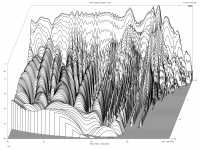
The measurement conditions were the same as for my ribbon, the scale is also the same as for the CSD of the ribbon. The frequency response is highly irregular and the overall picture looks like an artistic rendering of Bryce Canyon.
The normalised horizontal directivity of the Fostex FE108∑:
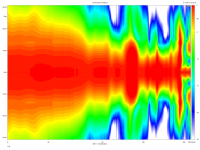
Just as the frequency response the directivity is all over the place. I don't think the Fostex FE103 will do any better and as such it is no match for my ribbon.
Some say that measurements don't tell the whole story when it comes to loudspeakers, that may be true for single measurements but if one driver outperforms another in nearly every measurement (except sensitivity) I think it is safe to say that that is the better driver.
I used the Fostex in the Voigt pipe as surround loudspeakers.
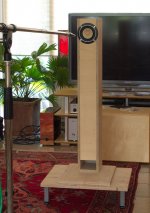
They've been replaced by my 'Pluto' clone (this was before the LX mini)
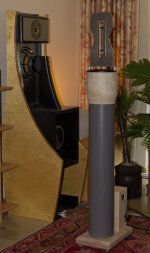
I call it ODi, short for Omnipole-dipole. My own design is so much better (measurements and sound) that I gave the Fostex away. Compared to the Linkwitz Orion they have a more open presentation and more focused imaging.
My 'Totem of Tone' design with the minimal ribbon takes this to the next level with an even more open presentation (the loudspeakers completely disappear) and focused imaging.
regards,
Gerrit
Tangent story...lost many years of measurements when hard drive failed on test computer.
Note to self, make regular backups.
However, I did manage to locate a screenshot I had emailed a friend.
Ribbon size was 3/4" x 3.5" (19mm x 90mm) with minimal frame similar to yours.
Measurement was taken 1m on-axis, with 1/24oct smoothing applied.
I just remembered one other thing I experimented with that you may be interested in was using a curved piece of 60% open area perforated sheet metal as a magnetic return path on the back side. It had minimal effect on the response and bumped up the sensitivity by +3dB. Hopefully I can locate a screen shot comparing the response.
Note to self, make regular backups.
However, I did manage to locate a screenshot I had emailed a friend.
Ribbon size was 3/4" x 3.5" (19mm x 90mm) with minimal frame similar to yours.
Measurement was taken 1m on-axis, with 1/24oct smoothing applied.
I just remembered one other thing I experimented with that you may be interested in was using a curved piece of 60% open area perforated sheet metal as a magnetic return path on the back side. It had minimal effect on the response and bumped up the sensitivity by +3dB. Hopefully I can locate a screen shot comparing the response.
Attachments
Very nice result indeed!Tangent story...lost many years of measurements when hard drive failed on test computer.
Note to self, make regular backups.
However, I did manage to locate a screenshot I had emailed a friend.
Ribbon size was 3/4" x 3.5" (19mm x 90mm) with minimal frame similar to yours.
Measurement was taken 1m on-axis, with 1/24oct smoothing applied.
I just remembered one other thing I experimented with that you may be interested in was using a curved piece of 60% open area perforated sheet metal as a magnetic return path on the back side. It had minimal effect on the response and bumped up the sensitivity by +3dB. Hopefully I can locate a screen shot comparing the response.
My next experiment will be to try to turn the ribbon into a cardioid by applying damping at the back. This should result in much more output and also makes it possible to place the ribbons close to the back wall.
What did you use to drive the ribbon?
regards,
Gerrit
Ribbon was driven with ATI 1202 amplifier thru a 3 ohm series resistor.What did you use to drive the ribbon?
I used the reference probe input from PRAXIS to measure voltage across the 3 ohm resistor which would be proportional to current thru the ribbon. By using the reference probe signal PRAXIS automatically adjusts for any variation in amplifier response, so the frequency response shown is truly for constant current drive signal.
I'm very impressed! Very professional article/build!
Are the magnets poles really directed towards listener, or have I missed something??
"It’s even called ribbon cable Duh"
Thank you
No, the poles are directed towards the gap just as with any true ribbon driver.
Here's the simulation in FEMM, top view:

regards,
Gerrit
Okay, I didn't know that magnets polarized in this way were available!
If I may ask, where did You buy them?
They're custom made, see page two of this thread for details. Forum member Bolserst also provided some links (on the same page) to readily available magnets with this polarisation.
regards,
Gerrit
They're custom made, see page two of this thread for details. Forum member Bolserst also provided some links (on the same page) to readily available magnets with this polarisation.
regards,
Gerrit
Jonas, didn't I tell myself to read the whole tread before putting unnecessary questions?
Yes, but I was all fired up.....
www.superstatic.se
Last edited:
Jonas, didn't I tell myself to read the whole tread before putting unnecessary questions?
Yes, but I was all fired up.....
Superstatic
The double magnet construction results in a significant reduction of the distortion. Here's a comparison of my minimal ribbon and Neo10 (response in blue, THD in orange) and my earlier steel frame ribbon with single magnets (response in red, THD in green). The dimensions of the ribbon are the same.
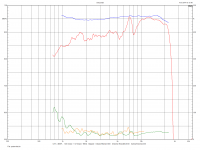
The scale for the distortion is in % on the right side of the graph. The THD is about the same but the level of the minimal ribbon is higher and the minimal ribbon has a 12dB boost at 2kHz to compensate the dipole loss. The response for the earlier design also shows a severe resonance problem at 7kHz. This is a result of the applied corrugation, the new method with the ribbon cable corrugation does not have this problem.
regards,
Gerrit
They're custom made, ...
regards,
Gerrit
This would be a really interesting candidate for a group buy. Gerrit if you were obligated to buy far more than you need, are you interested in selling off excess. Sounds like there would be lots of takers.
- Home
- Loudspeakers
- Planars & Exotics
- DIY ribbon dipole tweeter, reductio ad minimum
